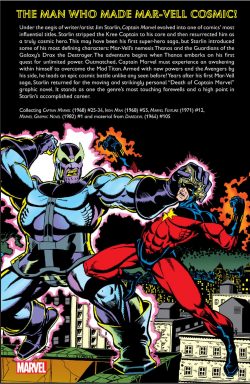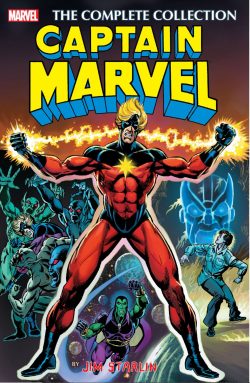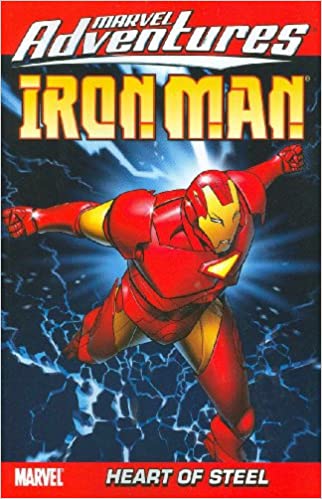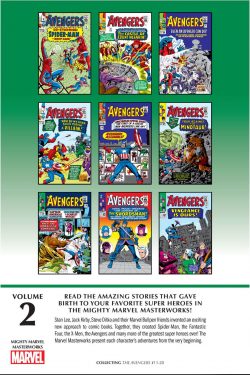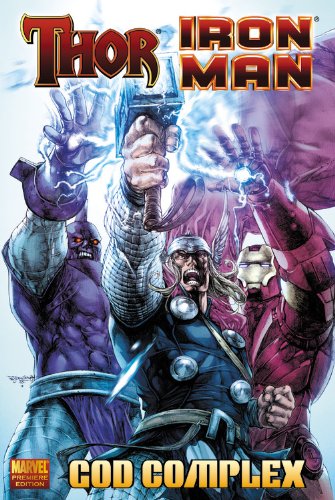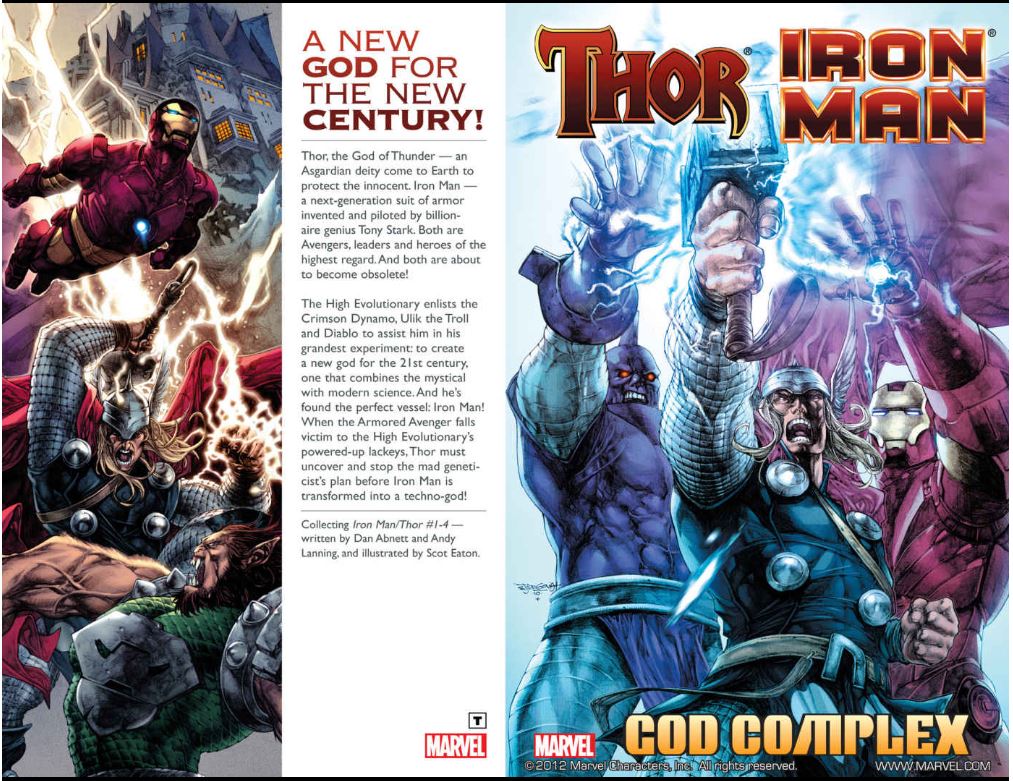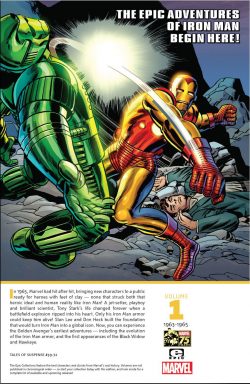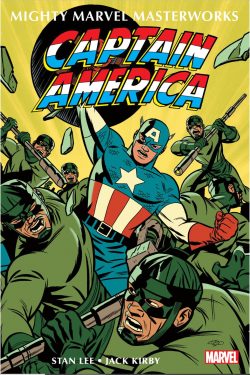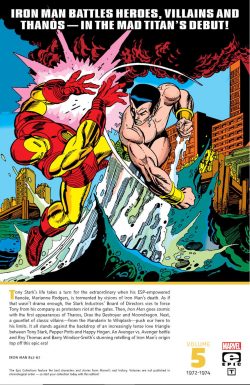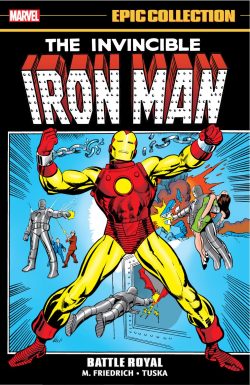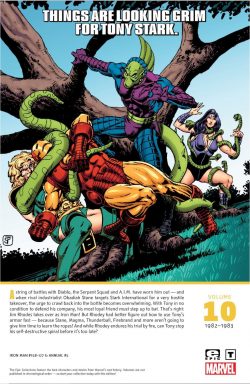

By Denny O’Neil, Roger McKenzie, Peter B. Gillis, Ralph Macchio, Carmine Infantino, Steve Ditko, Paul Smith, Luke McDonnell, Jerry Bingham, Mike Vosburg, Marie Severin & various (Marvel)
ISBN: 978-0-7851-8787-5 (TPB/Digital edition)
Tony Stark is a super-rich supergenius inventor who moonlights as a superhero: wearing a formidable, ever-evolving suit of armour stuffed with his own ingenious creations. The supreme technologist hates to lose and constantly upgrades his gear, making Iron Man one of the most powerful characters in the Marvel Universe.
However, in Iron Man #120-128 (March to November 1979), the unrelenting pressure of running a multinational corporation and saving the world on a daily basis resulted in the weary warrior succumbing to the constant temptations of his (originally sham) sybaritic lifestyle. Thus, he helplessly slipped into a glittering world drenched with excessive partying and drinking.
That dereliction was compounded by his armour being usurped by rival Justin Hammer: used to murder an innocent. The ensuing psychological crisis forced Stark to confront the hard fact that he was an alcoholic …and probably an adrenaline junkie too.
That crux landmark story ‘Demon in a Bottle’ saw the traumatised hero plumb the depths of grief and guilt, bury himself in pity, and alienate all his friends and allies before an unlikely intervention forced him to take a long, hard look at his life and actions…
A more cautious, level-headed and wiser man, Stark resumed his high-pressure lives, but he could not let up and the craving never went away. Then in 1982 author/editor Denny O’Neil made him do it again, with the result that Marvel gained another black superhero at long last…
It was the start of a period of legacy heroes inheriting the mantles, established roles and combat identities from white and mostly male champions, and was certainly a move in the right direction…
This grand and gleaming chronological compendium navigates that transitional period, re-presenting Iron Man #158-177 and Iron Man Annual #5: episodically spanning cover-dates May 1982 through December 1983, as the title experienced an uncomfortable number of creative personnel shuffles before settling on a steady team to tackle the biggest of changes…
It starts with Iron Man #158 as O’Neil, Carmine Infantino, Dan Green & Al Milgrom breeze through the motions as a deranged junior genius attacks modern technology from his literal man-cave by tapping the latent psychic power of his ‘Moms’…
Roger McKenzie, rising art star Paul Smith & inking collective “Diverse Hands” stepped in to relate what occurs ‘When Strikes Diablo’, as the Fantastic Four’s alchemical nemesis infiltrates Stark International to steal the techno-wizard’s resources and obsolete suits, only to unleash a mystic menace beyond all control…
With pressure mounting and threats everywhere, the craving for booze painfully manifests in ‘A Cry of Beasts’ – by O’Neil, Steve Ditko, Marie Severin & Green – as Stark’s party-persona collides with hot, willing babes …until an attack on his factory by the sinister Serpent Squad reminds him of his priorities.
Preceding Iron Man Annual #5, and by O’Neil, Luke McDonnell, Mike Esposito & Steve Mitchell, a brief encounter with newcomer hero Moon Knight sees Stark at odds with rival rich man Steven Grant (one of four people comprising the edgy new crusader) in ‘If the Moonman Should Fail!’
Frenemies at first sight, the Golden Avenger and Fist of Khonshu swallow their differences to save mutual friends held hostage by Advanced Idea Mechanics, after which the extra-length Annual extravaganza sees Iron Man in Wakanda where The Black Panther must defeat mysteriously resurrected nemesis and determined usurper Eric Killmonger…
Crafted by Peter B. Gillis, Ralph Macchio, Jerry & Bingham & Green, the action-packed ‘War and Remembrance!’ reveals an old foe methodically manoeuvring Stark and Iron Man into an inescapable trap, which closes tighter in Iron Man #162 as O’Neil, Mike Vosburg & Mitchell expose ‘The Menace Within!’ as a trusted employee sabotages S.I.…
There seems to be more than one campaign to crush Stark, and – as O’Neil, McDonnell & Mitchell become the regular creative team – ‘Knight’s Errand!’ opens an extended gambit with another hidden plotter turning ruthless capitalism, corporate raiding, advanced weaponry and an obsession with chess into a war for control of the company.
Up first is fast-flying tech terror The Knight who makes short work of Tony’s bodyguard, pilot, friend and confidante James Rhodey, but the real threat comes from a new acquaintance and future companion, covertly hollowing out Stark at close hand. Rising in the rankings after defeating the hovering horseman, Iron Man barely survives the ‘Deadly Blessing’ of The Bishop after his security team digs up leads to the plot in Scotland…
In IM #165, the trail leads to Jamie, Laird of Glen Travail and another deadly duel of devices, but the true purpose is to destabilise Stark by abducting Rhodey in an effort to coerce his capitulation. The resultant ‘Endgame’ seemingly goes Stark’s way, but the battle is fought on many levels by a distanced player secretly commanding the Laird: one with a cruel emotional counterpunch long-prepared to destroy the hero from within…
After a brief interlude offering original art pages from issues #161, 163 & 165, the stories resume and tensions mount on ‘One of Those Days…’ as old foe The Melter attacks Stark’s New York facility. Rhodey is recuperating in Scotland and Stark yet again faces enforced inactivity in the land of sublime alcoholic beverages, so he abruptly abandons his friend and jets home to stop the supervillain. He also learns his brilliant head of security Vic Martinelli has uncovered the identity of one of the hidden players attacking the company: chess grandmaster turned armaments entrepreneur Obadiah Stane…
With Rhodey missing again in Scotland, the newcomer wants all Stark’s creations and in the most hostile of takeovers, has used every trick in the book – from honey traps to guided missiles and abduction to intoxication – to seize the advantage…
‘The Empty Shell’ sees that nefarious planning bear evil fruit as Stark finally cracks under interminable pressure and one last betrayal, leading to a crushing fall “off the wagon” and into the gutter in ‘The Iron Scream’.
Permanently drunk and deprived of all judgement, Stark dons his armour to clash with Machine Man, even as far away, Rhodey makes his own life-threatening break for freedom and home…
As chaos ensues at the Stark plant, a major player debuts in the form of junior employee and minor boffin Morley Erwin, who’s on hand for Stark’s reunion with Rhodey and an aghast witness to one of the smartest men alive willingly crawling into a bottle and trying to drown away his pain…
That process begins in #169 as ‘Blackout!’ sees Stark simply give up when confronted by volcanic B-list villain Magma, and sleep through the moment Jim Rhodes steps up – and into – the role and armour of Iron Man…
The new era properly begins in #170’s ‘And Who Shall Clothe Himself in Iron?’ (cover-dated May 1983) as the former military airman promotes Erwin to the role of tech support adviser to help him pilot the most complex weapon he’s ever used to defeat Magma and save a far from grateful Tony Stark…
In the aftermath, the inventor just walks away: letting a new hero flounder even as, in the shadows, Stane gradually completes his takeover. Alone, isolated and under resourced, Rhodey and Erwin stumble into a heist in ‘Ball and Chain’, after seeking to arbitrate a domestic hostage situation triggered by Asgardian-powered supervillain Thunderball not knowing when no means no…
They are then duty-bound to intervene when Stark – completely off the rails – is arrested. However, his drunken debacle is only the start of their woes, as one the souse’s most murderous enemies tries to exact ‘Firebrand’s Revenge!’ and an entire hotel goes up in flames.
Thankfully Captain America is on hand to give the new guy in the suit a helping hand, but the distraction is just what Stane needs to seal his deal…
Homeless, broke and close to death on the streets, Stark is then accidentally saved by his conqueror, who lays the seeds of his own eventual downfall by dragging the lush to a grand takeover ceremony. Also attending is the new Iron Man who gets a lead to the woman who tempted and crushed Stark: an operative of freelance espionage ring The Sisters of Ishtar. This time both Stane and Rhodey learn that ‘Judas is a Woman’…
During this period every effort to turn Stark around fails: shot down by his self-sabotage. Now however, his friends must pause their personal interventions as the national and international repercussions of Stane’s triumph grows. Refusing to let a ruthless war profiteer benefit from Iron Man tech, Rhodey and Morley take drastic steps: stealing all the old kit and prototypes from Stane International. They are blithely unaware Nick Fury and S.H.I.E.L.D. share those opinions and are making their own clandestine arrangements in ‘Armor Chase’ (inked by Sam de LaRosa)…
A three-way clash escalates in O’Neil, McDonnell, & Mitchell’s Iron Man #175 as all ‘This Treasure of Red and Gold…’ ends up dumped deep in the ocean: purportedly beyond human reach. Nobody seemed to think that maybe water breathers like bellicose Atlantean renegade Warlord Krang might be in the market for a weapons upgrade dropped right in his lap…
Still operating under what can only be described as trial-by-fire period, Rhodey dives right in, triumphs again and even makes a new friend…
Stark’s own deep descent is marginally arrested after befriending an elderly “un-homed” guy on the streets in ‘Turf’, even as far away Iron Man meets the Sisters of Ishtar again and has his first encounter with something not of this Earth…
This tome pauses for now with a transitional tale loaded with portents of bad times to come. After meeting Erwin’s even smarter sister Clytemnestra, Rhodey looks – after a chat with Heroes for Hire Luke Cage & Iron Fist – into forming a rather unique start-up company in ‘Have Armor Will Travel’. The idea only truly gels after he’s hired to bodyguard an officious unflappable official in South America and encounters – and survives – deadly armoured mercenary Flying Tiger. However, in all the furore, our hero barely notices that he’s having headaches almost constantly these days…
To Be Continued…
With covers by Bob Layton, Smith, Jim Starlin, Ed Hannigan & Al Milgrom, Bingham & Brett Breeding, McDonnell, Brent Anderson & Mitchell, the bonus section includes ‘Original art and covers’, the cover for The Many Armors of Iron Man collection by McDonnell, Mitchell, & Frank D’Armata and contemporary House ad from Marvel Age #12.
As comics companies sought to course correct old attitudes and adapt their wares to a far wider and more diverse readership than they had previously acknowledged, some rash rushed decisions were made that did not suit all the fans. Thankfully, that never stopped the editors and publishers from trying and the wonderful results are here and everywhere in comics because of it. Go read and enjoy and see how it all began to change.
© 2017 Marvel Characters, Inc. All rights reserved.

